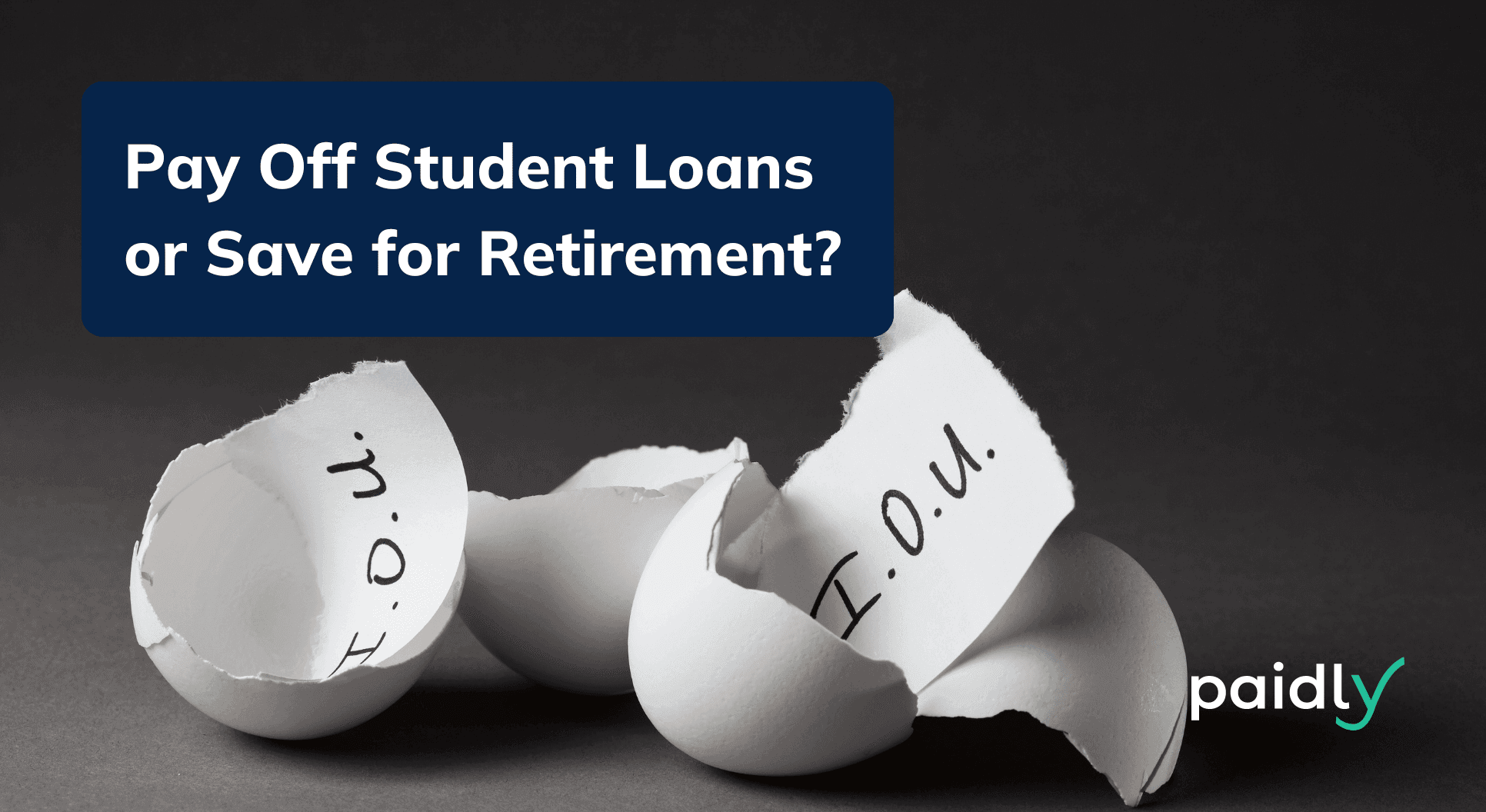Should I Pay Off My Student Loans or Save for Retirement?
Striving to balance student loan repayments with retirement savings? Allow us to guide you through a simplified approach that caters to harmonizing student loans and 401k contributions.

Key Takeaways
- Maximize the complimentary funds from your company tossed towards your 401k retirement savings, while effectively dealing with student loans. Remember, these seemingly conflicting lifestyles can thrive together.
- Secure Act 2.0 is now your guiding star to smoother retirement savings, also reducing the stress of student loans. It takes a holistic approach, balancing both student loans and 401k contributions.
- Innovative platforms like Paidly: Offering Student Loan Repayment Assistance, Paidly enables employers to help employees by contributing to their student loans, all as an employee benefit.
That Post-College Dilemma – Pay Off Student Loans or Start Saving for Retirement?
So you've finally graduated and are venturing out into the adult world. There's a big question that starts hovering over you like a cloud. Do you start paying off those pesky student loans or contribute to your 401k retirement savings? It's a tricky predicament, we know!

Addressing the Retirement Savings Anxiety
It's totally understandable to worry when putting money into your retirement savings. There seems like there's so much else to pay for right now! But let's flip the script and think about it this way, what happens if you put everything into paying off your student loans and saving zilch for retirement? There might be nothing left for your later years. Yikes!
Remember, if you're lucky enough to have an employer who matches your 401k contributions, essentially free money, should always be a priority. But the cardinal rule of paying off student loan debt, don’t miss payments. Make the minimum payment on every loan and ensure the amounts you pay fit into your monthly budget.
Unraveling Employer Matching: A Hidden Gem
Just like a magic trick, employer matching works wonders for amplifying your retirement savings. It resembles those wonderful 'two-for-one' deals, for every dollar you set aside for retirement, your employer adds another, up to a cap that's a certain percentage of your income. Talk about a fitting reward for saving, don't you agree?
The Intersection of Employer Contributions: Student Loans and 401k
Have you ever wondered what this has to do with your student loan paybacks? Be ready to be surprised. Envision this: each month, you allocate $100 for your student loans, and your employer, in turn, adds an extra 50% of this to your 401k.
This means for every $100 you utilize for student loan repayments, an additional $50 burgeons in your retirement fund. Cumulatively, each month your total financial well-being experiences a growth spurt to $150, effectively addressing both student debt and retirement savings simultaneously.
While this $50 contribution from your company may seem modest initially, its potential to produce exponential growth due to the magic of compounding garners more attention. Steadily chipping at your student loans while nurturing your retirement fund puts you in a financial win-win situation!

Cracking the Student Loan 401k Match: A Defining Perk
A term you may not be familiar with is the 'student loan 401k match.' Essentially, it's a profound benefit that allows simultaneous contributions to both your retirement fund and student loans, sweetened further with a company match. Suppose your annual salary amounts to $50K and you choose to contribute 4%. In this scenario, your contributions split evenly between student loans and consolidating that retirement nest egg.
Navigating the Retirement Journey with Secure Act 2.0
One giant stride to a brighter future comes in the form of the Secure Act 2.0, established in 2022. Its primary aim is to assist individuals in preparing for a fruitful retirement. This law introduces substantial changes that streamline the process for both employees and employers alike.
Essential Changes:
-
Pacing RMDs (Required Minimum Distributions): Now, you can postpone your RMDs till you reach 73, in place of 72. This age limit will increase to 75 by 2033, granting you the opportunity to amass more savings for retirement.
-
End to Pre-Death RMDs for Roth Accounts: A remarkable amendment in 2024, Roth accounts in plans will no longer have pre-death RMDs.
-
Good News for Part-Time Workers: By 2025, more part-timers will have the opportunity to save for retirement via salary deferrals.
-
Catch-Up Contributions Surge: Exciting! Beginning in 2025, individuals aged between 60 to 63 can now make greater catch-up contributions, up to $10,000!
Optional Changes:
-
Rewards for Savers: Innovative incentives created by employers for employees to enroll in retirement savings plans.
-
Student Loan Match: Absolutely fantastic! By 2024, your employer can match your retirement savings if you're diligently repaying your student loans. Farewell to student loan debt, hello to healthy retirement savings!
-
The Saver's Match: Here's a surprise: Starting in 2027, low-income workers can benefit from a federally funded match into their IRA or plan.
These reforms introduced by the Secure Act 2.0 illuminate a promising future for those eager to work towards a comfortable retirement while managing student loans. Even though it may take some time for the wheels to start turning, the anticipation of smoother retirement preparations is extremely encouraging. Stay tuned for our upcoming posts elaborating on the real benefits of the Secure Act 2.0!
Should You Pay Off Loans or Start Saving for 401k Retirement?
Individuals saddled with student loans often find themselves wrestling with the concept of retirement savings. It's understandable if sequestering funds for the distant future seems overwhelming, particularly as student loan demands pile up. You should continue to make the minimum payment on your student loans, while passing any surplus in your budget to your retirement saving efforts. But remember, starting to save earlier means your financial growth gets more time.

Proactive Approaches:
-
Maintain Base Loan Payments: Always make at least the minimum payment! If this proves daunting, explore income-driven repayment plans (IDRs). These plans adjust your monthly payments according to your budget, making them more user-friendly.
-
Optimize your 401k Contributions: If your employer provides a 401k match, seize it! It's essentially free money, so try to contribute as much as you can within the prescribed limit.
-
Shake off High-interest Debt: Handle credit card debt promptly as it grows at an alarming rate each month. Limit your credit card usage, prioritizing the repayment of your outstanding balance with any spare funds. Less debt equals greater freedom to channel more funds towards student loans and enhanced retirement savings.
-
Explore Traditional or Roth IRA: Employers' retirement plans aren't the only avenues for saving for retirement. Contemplate making tax-advantaged contributions to a traditional or Roth Individual Retirement Account (IRA). Even in the absence of employer contribution matching, continue investing. You may choose to deposit the same amount in a Roth IRA, forfeit immediate tax benefit, but relish tax-deferred growth and prospective tax-free withdrawals on qualifying distributions later.
-
Manage Surplus Funds Wisely: When a point arrives where your budget stretches comfortably, leaving you with surplus funds, careful utilization is crucial. Dedicate resources to clear outstanding debts, reward yourself, and consider investment options for any remaining cash.
When Contributing to Student Loans and 401k Retirement Becomes a Tightrope Walk
Attempting to maximize your employer's match contributions, but your lifestyle costs eat up your income? Let's dial down the anxiety!
Start off by investing the bare minimum into your retirement savings to leverage your employer's match. It might necessitate some budget-tightening, but remember, each small saving step ensures significant long-term gains.
If you find coping with your regular expenses a struggle, take a moment to review your outgoings. See if any areas allow for reasonable cutbacks.
When you successfully clear your student loans, it's time to reevaluate. Before plunging headlong into saving for retirement, evaluate if there are other debts (such as credit cards) requiring attention.
Leverage the Power of Student Loan Repayment Assistance with Paidly
Balancing your income between student loans and retirement savings often feels like an impossible puzzle. But Student Loan Repayment Assistance offers a soothing balm for student loan anxiety. Services like Paidly empower your employer to assist with your student loan repayments via an employee benefit. This contribution can be monthly or a lump sum payment, allowing your employer to help you decrease your student loan burden, tax-exempt up to $5,250 a year!
Striking the Perfect Balance with Student Loans and Retirement Savings
Juggling student loan repayments and retirement savings can feel like a tight-rope walk. However, equipped with the right tools, you can discover a balance that fits your personal financial landscape and helps you achieve a secure future. Keep focusing on your goals, as every step you take is a move towards a financially free future! Tell your employer to Meet Paidly or start on your own jounery with our Friends Helping Friends student loan donations solution.
Team Paidly
Paidly is a Student Loan Repayment Benefit platform. Leveraging over a decade and a half of Fintech, student loan origination, and refinancing experience. Paidly specializes in creating custom student loan repayment benefit plans, designed specifically to allow employers to pay directly towards their employees' student loans. Paidly's system requires no integration and enhances talent attraction and employee retention.
Join our newsletter
Don't miss any more news and subscribe to our newsletter today.
The information provided is of a general nature and an educational resource. It is not intended to provide advice or address the situation of any particular individual or entity. Any recipient shall be responsible for the use to which it puts this document. Paidly shall have no liability for the information provided. While care has been taken to produce this document, Paidly does not warrant, represent or guarantee the completeness, accuracy, adequacy, or fitness with respect to the information contained in this document. The information provided does not reflect new circumstances, or additional regulatory and legal changes. The issues addressed may have legal, financial, and health implications, and we recommend you speak to your legal, financial, and health advisors before acting on any of the information provided.
You may also like

Deciphering Your Rent Budget: Beyond the 30% Guideline
Is following the 30% rule for rent really the best choice? Let's delve into how it might be time to rethink your budget!

The 50-30-20 Rule: How to Budget Your Way Out of Student Loan Debt
Discover how the 50/30/20 rule can be your ally in mastering student loan repayments without the stress.

Offer Student Loan Repayment Benefits Through Your Brokerage
Differentiate your offerings, Introduce the benefit that the modern workforce is seeking.
